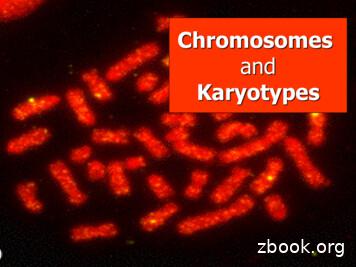Pedigrees And Karyotypes
Gene MappingHow do scientists track diseases like sickle cell anemiadown through family lines?
KARYOTYPE The number and visualappearance of thechromosomes of a specificorganism. This map only shows thechromosomes not theindividual genes
HOW TO MAKE ONE Arranged by homologouschromosomes and numberedbased on size and bandingpatterns. Autosomes are pairs #1-22 Sex chromosomes are pair #23 XX female human XY male human
THINK PAIR SHARE Is this organismhuman?Yes, it has 46chromosomes. Is it male or femaleand why?Male, has XY
PEDIGREE Shows a record of thefamily of an individual. Used to track geneticdisorders within a familyover several generations. Used today to trackpurebred animals
SYMBOLS USED IN PEDIGREE CHARTS Normal maleAffected maleNormal femaleAffected femaleMarriageCarrier femaleCarrier maleA mariage with five children, two daughtersand three sons. The middle son is affected bythe condition. The youngest daughter is acarrier of the condition.Eldest Child Youngest Child
ORGANISING THE PEDIGREE CHART Generations are identified by Roman numeralsIIIIIIIVHow manycarriers arerepresented?
INTERPRETING A PEDIGREE CHART1. Determine if the pedigree chart showsan autosomal or X-linked disease. If many more of the males in the pedigree areaffected the disorder is X-linked. If it is about a 50/50 ratio between men andwomen the disorder is probably autosomal.
st1EXAMPLE OF PEDIGREE CHARTSIs it Autosomal or X-linked?50/50 ratiobetween men andwomen havedisorder.
nd2EXAMPLE OF PEDIGREE CHARTS Is it Autosomal or X-linked?6 affected malesvs3 affected females(the rest are onlycarriers)
INTERPRETING A PEDIGREE CHART2. Determine whether the disorder isdominant or recessive. If the disorder is dominant, one of theparents must have the disorder. If the disorder is recessive, neitherparent has to have the disorderbecause they can be heterozygous.(Unless X-linked, then fathers will have therecessive disorder.)
rd3EXAMPLE OF PEDIGREE CHARTS Dominant or Recessive?Neither parents in the1st and 2ndgenerations areaffected by condition(they are only carriersof it) but some of theirchildren are.
rd3EXAMPLE OF PEDIGREE CHARTS Dominant or Recessive?Neither parents in the1st and 2ndgenerations areaffected by condition(they are only carriersof it) but some of theirchildren are.Carriers often wont berepresented in pedigreeproblems.It will be up to YOU tounderstand how torecognize them.
th4EXAMPLE OF PEDIGREE CHARTS Dominant or Recessive?At least 1 parent fromboth the 1st and 2ndgenerations areaffected bycondition.
th5EXAMPLE OF PEDIGREE CHARTS Is it Autosomal or X-linked? Dominant or recessive?4 males affectedvs1 female affectedRecessive, because theaffected female in 2ndgeneration only gave thedisorder to her sons.Daughters are onlycarriers.
THE MOST TECHNICAL MAP IS THECYTOLOGICAL MAP This shows the sequence (order of) genes along the chromosome. We can see the actual A,T,G and C order of each gene on thechromosome. Requires very high tech equipment to construct. Notice the traits of the fly are mapped (#) to tell their location and orderalong the leg of the chromosome
INTERPRETING A PEDIGREE CHART 2. Determine whether the disorder is dominant or recessive. If the disorder is dominant, one of the parents must have the disorder. If the disorder is recessive, neither parent has to have the disorder because they can be heterozygous. (Unless X-linked, then fathers will have the recessive disorder.)
Pedigrees and the Inheritance of Lactose Intolerance You are now going to examine three additional pedigrees from the Finnish study. Figure 3. Pedigrees of Families B, C, and D. (Adapted from a figure in Enattah, N. S., e
22 pairs (Chromosomes #1-22) Two Types of Chromosomes: 2. Sex Chromosomes: . A picture of the chromosomes in which the chromosomes arranged in matching (homologous) pairs . Karyotypes –Arranged in size order from largest pair to smallest pair –The sex chromosomes (X and Y) are usually
STANDARDIZATION OF GYMNOSPERM KARYOTYPES USING PICEA OMORIKA AS AN EXAMPLE kelimir Borzan', Marilena IdiojtiC1 & Helmut Guttenberger2 '' Faculty of Forestry, University of Zagreb. SvetoSimunska 25, HR-10000 Zagreb, Croatia ') Department of Plant Physiology,
2 Pedigrees of Upland and Pima Cotton Cultivars Released Between 1970 and 2005 (1) records from the Plant Variety Protection (PVP) Office, (2) Crop Science cultivar registration notices, and (3) Characteristics of Cotton Varieties Grown in Texas, editions 2 and 3 (Metzer et al. 1984, Metzer and Supak 1990, respectively).
" The picture of the chromosomes are then cut up so that each chromosome is removed. The chromosomes are matched up and attached to a paper according to size, banding patterns, & centromere position. " The chromosomes pairs are numbered from largest to smallest. " There are 22 pairs of chromosomes that are aligned first
A karyotype is the image or picture of the full set of chromosomes from an individual’s cell (Figure 7.1.2). A karyotype is represented by photographs or diagrams of the homologous chromosomes arranged in pairs according to their length and the position of the centromere. Karyotypes allow scientists to compare the chromosome sets of related .
Human Chromosomes. Karyotypes. Scientists then cut out the chromosomes from the photographs and arrange them in a picture known as a . karyotype. It shows the complete diploid set of chromosomes grouped together in pairs, arranged in order of decreasing size. A karyotype from a typical human cell, which contains 46 chromosomes, is arranged in .
In the English writing system, many of the graphemes (letters and letter groups) have more than one possible pronunciation. Sometimes, specific sequences of letters can alert the reader to the possible pronunciation required; for example, note the letter sequences shown as ‘hollow letters’ in this guide as in ‘watch’, ‘salt’ and ‘city’ - indicating that, in these words with .























